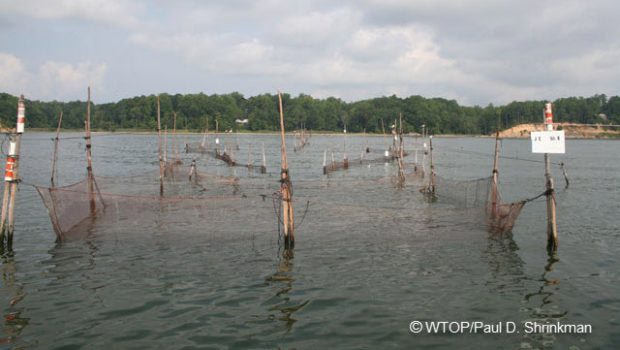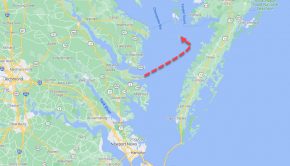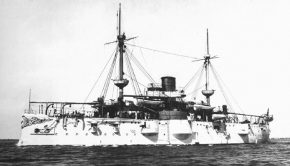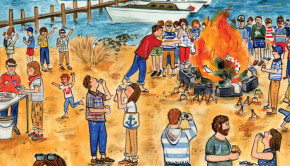Need a better lookout at night
Published on February 16th, 2022
Located in the Mid-Atlantic region, the Chesapeake Bay extends approximately 174nm from its northern headwaters in the Susquehanna River to its outlet in the Atlantic Ocean. It is the largest estuary in the United States with plenty of places to go.
Bill Wheary (Norfolk, VA) shares one such outing many years ago on Chesapeake Bay:
For many years, notably the 1970s and 1980s, the Chesapeake Bay was blessed with a great many overnight races. The Virginia Cruising Cup, often colloquially called the Down the Bay Race and the Annapolis to Hampton Race, was a 120 miler held in mid-July and too often sailed in the doldrums for which the Chesapeake Bay in summer is known.
There were other overnight point to point races such as the wildly popular Maryland Governor’s Cup Race from Annapolis to St. Mary’s City, MD. Many other races started from Hampton in the “lower bay” or Annapolis in the “upper bay” and traversed courses of 50 to 70 miles or so before finishing where they started.
In those days, before the invention of GPS and the use of Loran became widespread, sailors seemed content with dead-reckoning navigation, and distance racing in boats of 30 feet and less was common. Boats such as Running Tide (60’) and Cayenne (58’) were the exceptions.
One often rather challenging race was the Smith Point Light Race which was held in mid-May when the water had not yet warmed and the air could be on the cold side. Adding to the “charm” of this 108 mile race might be strong northerlies getting in their last punches before warm weather and the doldrums arrived.
The race started in the afternoon in the lower Chesapeake Bay off Ft. Monroe, headed almost due north for 54 miles before rounding Smith Point Light at the mouth of the Potomac River, and then straight back to the finish at Ft. Monroe. Smith Point Light is a 52-foot tall caisson lighthouse similar to many others on the Bay.
One year in the early 1980s, I did this race on Osprey, John and Sharon Newhard’s C&C 30, a spinnaker class boat. We started in mid-afternoon beating into a gradually building northerly. When darkness fell, we still faced several more hours of increasingly hard sailing. Approaching the lighthouse around 2:00am, the wind had increased to about 20 knots and Osprey was definitely overpowered.
When we first saw the lighthouse’s white light with its 10 second intervals, we felt like we were almost to our turning mark. But feathering the bladed out #1 jib and board flat main barely provided enough power to progress through the two to three foot seas rushing toward us after their long fetch down from Maryland.
But at last reaching the lighthouse, and taking into account the strong current and wind, we rounded well to the north to provide sufficient margin of error from being swept into the lighthouse. Whew! The hard part was done.
It was now all downwind. Piece of cake. What could possibly go wrong? We would simply fly the masthead spinnaker in the pitch black night, big seas and 20 knot wind and cruise to the finish line 54 miles away.
Being unable to see more than a couple of boat lengths ahead while we barreled along at 7 or 8 knots was a chance we would take. After all, we had not had any problems on the way north, or on any of the many other night races we had sailed.
We were well aware that this area of the Chesapeake Bay contained numerous fishing “pound nets”. A pound net is essentially a fence running from shallow water for 50 or 100 yards or more out toward deeper water. The fence consists of a net or nets suspended from a cable or heavy line which is attached at water level to saplings driven about 15 or 20 feet apart into the sandy bottom.
The upper end of the saplings extends for 10 feet or so above the water’s surface. The deep water end of the long net feeds into a circular net 30 or 40 feet in diameter. This is the pound. When fish heading up or down the Bay encounter the long, vertical net, they swim toward the deep water to get around the obstacle and become trapped in the pound.
Regulations specify that a pound net is to display a single light at each end and reflective tape of various colors at certain locations between the ends. However, even when we could see a pound net in ambient light, we almost never, if ever, saw any lights. And there was no ambient light on this night. Reflective tape would be of no use unless the beam of a light was shown at the tape, and we did not have a spare crew to shine a light for several hours.
Less than an hour after turning south, our wild and exciting spinnaker run through the darkness came to a sudden halt. We quickly realized that we had gone between two of the unseen saplings of a pound net and that the keel was hung up on the heavy line from which the net was suspended.
The boat was stopped, but 20 knots of wind was still filling the spinnaker and blowing hard against the main. Something would have to give, and soon. Would the spinnaker rip or shred? Would the boat be dragged onto its side? The main punctured and torn by a sapling? What might happen to the mast and the rig? Would the keel be pulled across the net cable which might then snag the rudder? Then what?
Well, we got lucky. Very lucky.
Somehow, both the keel and the rudder crossed the net and we were able to continue our journey south. Were the boat’s angle of heel and the wind’s force so significant that the keel and the rudder were able to slide across the net? Was the heavy line that held up the net cut or broken by the force of the keel? We never knew, but we did know that we had been very fortunate to have escaped with no injuries or damage to the boat.
This adventure did not cause us to stop our night racing, but we did keep a better lookout at night.









 We’ll keep your information safe.
We’ll keep your information safe.